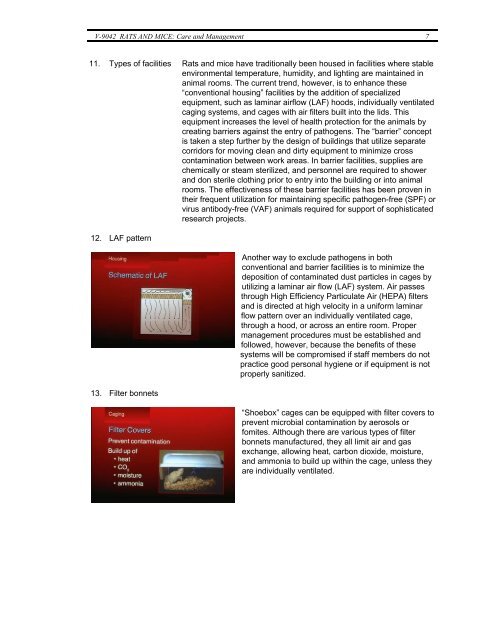LABORATORY ANIMAL MEDICINE AND SCIENCE - SERIES II ...
LABORATORY ANIMAL MEDICINE AND SCIENCE - SERIES II ...
LABORATORY ANIMAL MEDICINE AND SCIENCE - SERIES II ...
You also want an ePaper? Increase the reach of your titles
YUMPU automatically turns print PDFs into web optimized ePapers that Google loves.
V-9042 RATS <strong>AND</strong> MICE: Care and Management 711. Types of facilities Rats and mice have traditionally been housed in facilities where stableenvironmental temperature, humidity, and lighting are maintained inanimal rooms. The current trend, however, is to enhance these“conventional housing” facilities by the addition of specializedequipment, such as laminar airflow (LAF) hoods, individually ventilatedcaging systems, and cages with air filters built into the lids. Thisequipment increases the level of health protection for the animals bycreating barriers against the entry of pathogens. The “barrier” conceptis taken a step further by the design of buildings that utilize separatecorridors for moving clean and dirty equipment to minimize crosscontamination between work areas. In barrier facilities, supplies arechemically or steam sterilized, and personnel are required to showerand don sterile clothing prior to entry into the building or into animalrooms. The effectiveness of these barrier facilities has been proven intheir frequent utilization for maintaining specific pathogen-free (SPF) orvirus antibody-free (VAF) animals required for support of sophisticatedresearch projects.12. LAF pattern13. Filter bonnetsAnother way to exclude pathogens in bothconventional and barrier facilities is to minimize thedeposition of contaminated dust particles in cages byutilizing a laminar air flow (LAF) system. Air passesthrough High Efficiency Particulate Air (HEPA) filtersand is directed at high velocity in a uniform laminarflow pattern over an individually ventilated cage,through a hood, or across an entire room. Propermanagement procedures must be established andfollowed, however, because the benefits of thesesystems will be compromised if staff members do notpractice good personal hygiene or if equipment is notproperly sanitized.“Shoebox” cages can be equipped with filter covers toprevent microbial contamination by aerosols orfomites. Although there are various types of filterbonnets manufactured, they all limit air and gasexchange, allowing heat, carbon dioxide, moisture,and ammonia to build up within the cage, unless theyare individually ventilated.


